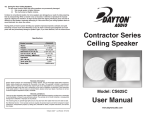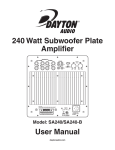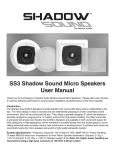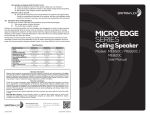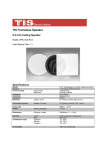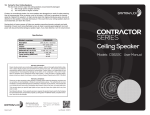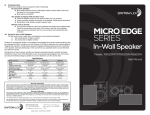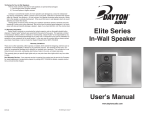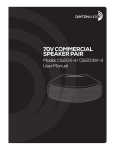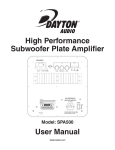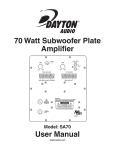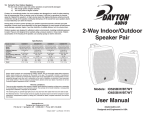Download CS620C_CS620CT_CS820C_CS820CT Manual.indd
Transcript
● Check the balance control on the receiver. Make sure it is centered. Loose connection at either the receiver or the speaker. Double check connections. ● Bad speaker cable. Replace suspect speaker cable. ● Receiver cuts on and off: ● This could be caused by a short circuit between the positive and negative leads. Check the connections at the back of the receiver, and then at the speaker; make sure that no strands of wire from one connector are touching the other connector. 10) Caring For Your Ceiling Speakers The two most common ways that ceiling speakers are permanently damaged: 1) Not enough power at higher volumes. 2) Too much power at higher volumes. Contrary to conventional wisdom, far more speakers are damaged as a result of under-powering, than by overpowering. When a receiver runs out of power, it still tries to reproduce the musical signal by “clipping” the waveform. At high volume levels this clipping introduces gross amounts of distortion to the speaker, eventually destroying it. If the sound from your ceiling speakers starts to sound distorted, turn down the volume. Having plenty of reserve power will help your speakers reproduce dynamic contrasts and quick transients of music much more effectively, but you do have to exercise good judgment; too much power will also permanently damage a speaker. Again, if you hear distortion, turn the volume down. Contractor Series Ceiling Speaker Specifications Model number Description 70V Taps Woofer Tweeter Frequency response (Hz) Dimensions H x W x D (in) Cut-out size H x W (in) Power handling (RMS/Peak) SPL (1W/1m) CS620C CS620CT 8 ohm NA 6.5" Poly cone 1" Mylar 60-20,000 8-1/2" dia x 2-3/4" 7-3/8" dia. 30/60 88dB 70V / 8 ohm 0.62, 1.25, 2.5, 5, 10 W 6.5" Poly cone 1" Mylar 60-20,000 8-1/2" dia x 2-3/4" 7-3/8" dia. 30/60 88dB CS820C CS820CT 8 ohm 70V / 8 ohm NA 0.62, 1.25, 2.5, 5, 10 W 8" Poly cone 8” Poly cone 1" Mylar 1” Mylar 50-20,000 50-20,000 10-3/4" dia x 3-5/8" 10-3/4” dia x 3-5/8” 9-1/8" dia. 9-1/8” dia. 30/60 30/60 89dB 89dB Warranty Information Dayton Audio® products are constructed by industry experts, and are thoroughly tested before shipment. Dayton Audio products are warranted for the period of one year. This warranty is limited to manufacturer defects, either in materials or workmanship. Dayton Audio is not responsible for any consequential on inconsequential damage to any other unit or component or the cost for installation or extraction of any component of the audio system. In the rare case of a product failure, please contact your place of purchase or call our Customer Support Department at (937) 743-8248. Warranty Limitations There are no other warranties, either express or implied, which extend the foregoing, and there are no warranties of merchantability or fitness for any particular purpose. The warranty will not cover incidental or consequential damage due to defective or improper use of products. This warranty gives you specific legal rights and you may also have other rights which vary from state to state. Non-Warranty Service: If non-warranty service is required, the product may be sent to the Company for repair/ replacement, transportation prepaid, by calling (937) 743-8248 for details, complete instructions, and service fee charges. © Dayton Audio® Last Revised: 9/11/2012 Models: CS620C CS620CT CS820C CS820CT User Manual www.daytonaudio.com Congratulations on the purchase of your Dayton Audio® Contractor Series Ceiling Speakers. These speakers were manufactured with high quality components and engineered to deliver top quality sound performance. fit loosely and the speaker frame should cover the edges of the hole. Repeat these steps for the other speaker. 5) Speaker Cable Don’t compromise sound quality by using thin, inexpensive speaker wire, we recommend using a high quality oxygen free copper speaker cable. For runs less than 50 feet we recommend 16 gauge cable, and for longer runs we recommend 14 gauge or larger cable. For installations with in-room stereo volume controls we recommend using a four conductor speaker wire from receiver to volume controls. Most municipalities require the use of CL2 rated speaker cable for installation in walls and ceilings. Leave enough speaker cable so you can stand comfortably on the floor or ladder while connecting the speaker cable to the speakers. 6) Speaker Connection Remove about 8" of the cable jacket to expose the inner conductors. Strip 1/4" of insulation from each conductor and connect to the speaker terminals. When connecting the wires to the speakers, be sure to observe proper polarity. Most CL2 rated speaker cable will have red and black conductors so you will connect the red wire to the red speaker terminal and the black wire to the black speaker terminal. ● Long-throw polypropylene cone woofers with rubber surround ● Coaxially mounted 1" mylar tweeter ● Optimized crossover Please read these instructions completely before you begin your installation. 1) Parts Inventory Your speaker kit should include the following: ● 1 pair of Dayton Audio Contractor Series Ceiling Speakers with Grills ● 1 speaker installation / paint masking template 2) Installation Tools The Dayton Audio speakers can be installed with the following simple tools: ● Pencil ● #2 Phillips screwdriver ● Masking tape ● Wire cutters & wire stripper/crimp tool ● Drill & drill bits ● Stud finder** ● Utility knife or wallboard saw* * Recommended for use if installing in plaster walls. ** Optional tools to make the installation easier. 3) Speaker Location To achieve the best performance from your Dayton Audio speakers, it is important to carefully select the location for installation. Your ceiling speakers should be installed 5 to 8 feet apart to ensure proper stereo imaging. Mount each speaker the same distance from the intersecting walls to maintain a uniform look. Keep the speakers at least 2 feet away from the corners of the room to avoid overemphasized bass reproduction. 4) For high impedance (70 V) applications attach the positive lead from the receiver to the wattage lead on 70 V transformer to be used (i.e. 2.5W) and the negative lead from the receiver to the to the common ground lead (C) on 70 V transformer. For Low Impedance (8 ohm) applications connect the positive lead from the receiver to the RED positive terminal on the speaker and the negative lead from the receiver to the BLACK negative terminal on the speaker. Note: To avoid damage to the speaker, be sure to switch off the amplifier power when changing the input. Speaker Installation Once you have selected the location for your speakers, you are ready to install them. CAUTION: Be certain that there are no electrical wires, water pipes, or heating ducts in the planned installation area before you start drilling or cutting into the ceiling. If there is an electrical outlet nearby, turn off the circuit breaker to avoid possible injury. 7) Ceiling speakers are designed to be mounted in the ceiling between the joists or trusses. Once you have selected the location, check to be sure you are between the joists or truss. One method is to tap on the ceiling, you will hear a hollow sound when between two joists or trusses and a sharper, more solid sound when right on top of, or close to a joist or truss. An easier, more accurate method for finding the location of joists or trusses is to use a stud finder. The Contractor Series Ceiling speakers include a two-part template. Remove the center circle from the template, this is a paint masking template to use if you choose to paint the speaker frames and grill. The outer ring is used to mark the cut-out for the speakers. Once you have established that your chosen location is between two joists or trusses, and that there are no obstructions in the ceiling, tape your speaker template to the ceiling and lightly trace around the inside edge with a pencil and drill a 1" hole in the center of the template outline. Next, use a piece of stiff wire (a coat hanger works well), bend it 8" from the end at a 90 degree angle. Insert the bent part of the coat hanger into the 1" hole and rotate the wire in a complete circle to check for obstructions. If the wire hits a stud on either side, reposition your template to the left or right and mark the outline again. Keep the pilot hole within the template outline. If the ceiling is made of drywall, simply cut the marked area with your utility knife or drywall saw. If the ceiling is made of plaster, you should use a saw with a higher tooth count to reduce the chance of breaking the plaster. Test fit the speaker in the hole, the speaker should Final Installation To install the speakers into the ceiling, remove the grills, this will give you access to the mounting screws. Turn the mounting clamps so they are positioned as in the illustration, this will allow the speakers to clear the hole for installation. Insert the speaker into the hole, and tighten the mounting screws. As you turn each screw, the mounting clamps will rotate outward to engage ceiling material. CAUTION: Do Not Over-Tighten the Clamps. Too much torque may snap off the lug and the speaker will not seat securely. A snug fit is all that is necessary to assure proper performance. 8) Painting Speakers If you choose to paint the speaker grill and/or frame we have provided a “Paint Masking Template” to cover the woofer/tweeter assembly and help prevent possible damage. Do not try to paint the frame and grill assembly together, the grill should always be painted separately. Do not apply heavy coats of paint that might block the perforations in the grill. 9) Troubleshooting Should your speakers not work properly, check the following: No sound from speakers: ● Most stereo receivers have an A/B speaker selector switch. Make certain that this switch is in the proper position. ● Mute feature is activated. One speaker is playing while the other is not:




